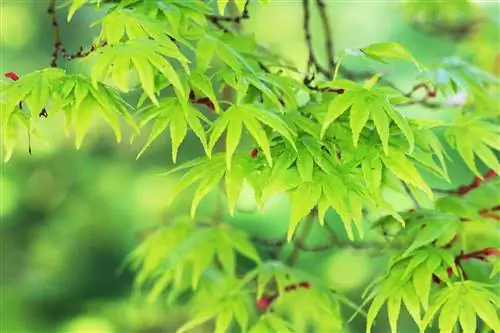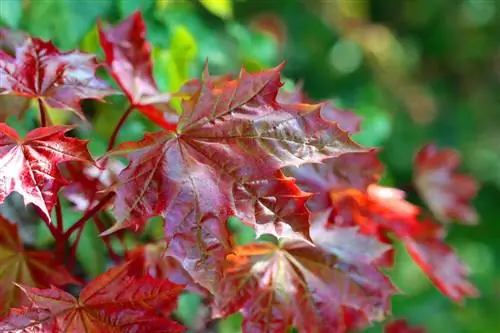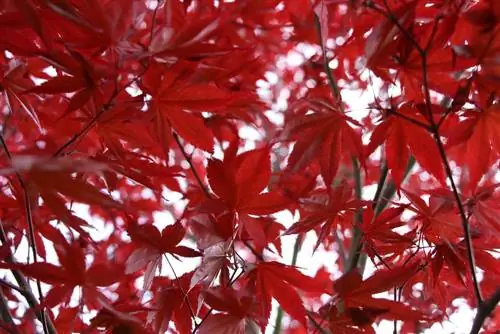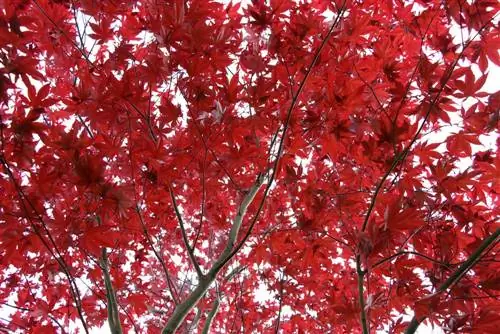- Author admin [email protected].
- Public 2023-12-17 03:39.
- Last modified 2025-01-24 12:45.
The deciduous field maple (Acer Campestre) belongs to the soap tree family (Sapindaceae) and the maple genus. As green as it appears in summer, it shines brightly in yellow-orange-brown in autumn. Due to its wood grain as well as the similar growth of the elderberry and its former use as a food tree, the field maple is also called “Maßholder”. The field maple grows as a tree under favorable conditions up to 20 meters high and 15 meters wide and can live 200 years. In its natural form, the field maple often grows with multiple trunks and has a rounded to egg-shaped crown. The strong cardiac root system is generally insensitive. Young branches sometimes form cork strips and are very tolerant of pruning. The field maple blooms from May to June. The field maple is a popular place for birds to shelter and nest.
There are different types and cultivation forms of the field maple:
- Red field maple: five-lobed, pointed leaves with a bronze shimmer, dark red when budding and golden yellow in autumn
- Carnival: has white variegated (multicolored) leaves that are pink when they shoot
- Elsrijk (cone field maple): compact conical tree crown, tolerates drought well, is less susceptible to powdery mildew infestation
- Nanum: grows weakly and spherically, is often offered as a refined log
- Postelense: was discovered in Silesia in 1896, can often be seen in old parks, young leaves are golden yellow and increasingly turn green in summer
- Zöschener Ahorn: a garden hybrid of the Calabrian maple with the field maple
Plant correctly
The field maple in its various species is a very decorative tree in its natural form. If you would like to grow the tree in its entirety in an open area to create an impressive eye-catcher or plant it in a shrubby form as a hedge, you should start with choose the optimal location. Under good environmental conditions, the field maple grows very quickly. The choice of location for the maple is very important because it needs to develop unhindered. This also applies to species with low stature. The best location is a sunny to shady location on typical Central European soil. Waterlogging endangers the tree. If you want to plant the field maple as a hedge, you need 2 to 3 plants per meter. The Maßholder grows 40 to 60 cm per year.
Optimal location summarized:
- sunny to semi-shady location
- unhindered growth opportunity
- Soil optimal: nutrient-rich, moist to dry, low humus content, generally normal soil
- Soil unfavorable: waterlogging, acidic and clayey soil
- Climate: warm to cool, tolerates frost and heat, urban climate, withstands wind
The field maple is a very robust, undemanding and frost-resistant tree. The best time to plant often depends on the type of cultivation of the plants, for example outdoor plants or container plants. It is best to plant the field maple in November. Young trees form fine roots before the onset of winter. The hedge plant takes off right away in spring. However, you can also plant a well-rooted container plant in late spring and summer. Loosen the soil a little and mix in some compost and horn shavings.
Care and cutting
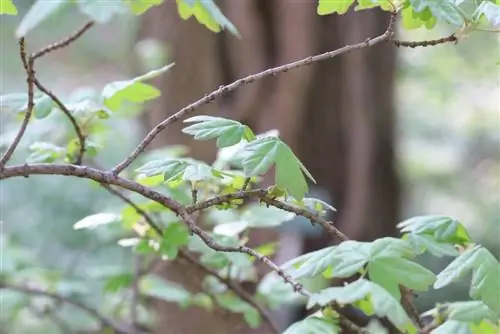
The field maple requires hardly any care or fertilization. It grows on its own in almost all locations, provided the environmental conditions correspond to its nature. A heavy fall of leaves can be expected in autumn. Mulching is recommended in spring to prevent drying out. A field maple that is to be shaped or used as a hedge must be trimmed regularly. As a hedge, it should be cut once or twice a year. It is important that the field maple is cut during dormancy as the growth break. In this phase, the tree only loses its sap slightly and is therefore not weakened. Under no circumstances should you prune in spring!
The dormant phase begins in late summer. The best cutting time is in autumn and late winter. It is recommended to initially cut off just one branch and check whether the plant sap is low enough. After pruning, the larger interfaces of the branches should be coated with tree wax. The right cutting device depends on the branch thickness. The selection ranges from pruning shears to loppers to fretsaws.
Diseases, pests, what now?
After cutting and in general, field maples can also be attacked by diseases and pests. The field maple can be affected by diseases such as powdery mildew, leaf spots, tree canker or Nectria galligena, aphids or the Verticillium wilt fungal disease. In the case of powdery mildew, the fallen leaves and infected shoots are removed immediately. In the garden, powdery mildew fungi can be treated with wet sulfur or mildew treatment.
In the case of tree canker, a fungal infection that causes the bark to crack, affected twigs and branches must be removed and burned. If the trunk is infected, a specialist should be called. If field maples are affected by tracheomycosis (brown coloring of the leaves), it may be a vascular parasitic fungal disease. This should also be examined by a specialist. Field maples are very often attacked by gall mites, but these do not harm the tree and do not require control.
Mushrooms that are harmful to the tree are the honey fungus, the tinder fungus, the sparriger Schuppling, butterfly trame, burnt smoke fungus or the fire crust fungus. In these cases, specialist experts should be consulted. However, there are also many damages and fungi that do not harm the field maple and do not need to be treated. These include leaf spots, aphids and the frost-hardy fungus “velvet-footed rubble”. Although the leaf cutter bees cut circular pieces into the leaves of the field maple, they are beneficial insects that must not be controlled under any circumstances. The bees build the “stolen” leaf pieces into their brood tubes.
As a free-standing tree and as a hedge, the field maple is a very attractive tree plant. As a very robust and undemanding plant, it can be planted almost anywhere and easily and later shaped. Severe tree infestations such as harmful fungi or parasites should be examined by a specialist.
What you should know in brief
- The field maple is also called massholder, while its scientific name is Acer campestre.
- It is a species of deciduous tree and belongs to the maple genus. It can live between 150 and 200 years.
- As a rule, the field maple remains shrub-like in size and only grows to a height of between 10 and 15 meters under favorable conditions.
- However, there are also individual cases that have reached a height of 20 to 25 meters, with the trunk circumference being a good one meter.
- The bark of the field maple is brown to brown-grey and cracked. Sometimes young branches form cork strips that are very easy to cut.
- The leaves are three to five-lobed and have blunt lobes, while the bays between the lobes are always pointed.
- The leaves are also opposite, i.e. two leaves grow opposite each other on a branch and there are no stipules.
- Furthermore, the leaves are dark green and grey-green and finely hairy on the underside. They turn yellow and orange in October.
- The tree has an intensive cardiac root system, which is quite insensitive. However, the field maple does not grow so well on highly acidic or clayey soil.
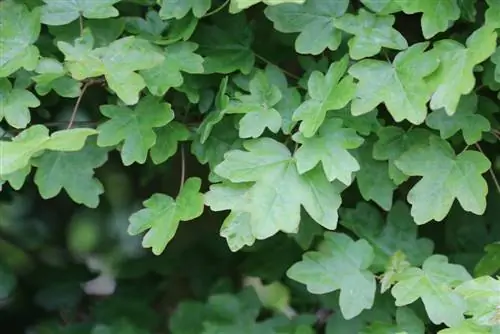
The flowers of the field maple grow together in upright corymbs and are monoecious, whereby a flower always has both sexes, of which only one is properly developed. The flowering period is in May and June, while the fruit ripens in September to October. The fruits of the field maple are gray felt-like nuts with two horizontally protruding wings. The partial fruits are 2.5 - 3 cm long and 6 - 10 mm wide. If the tree is 15 to 20 years old, it is ready to bloom.
The occurrence of the field maple extends across the entire Mediterranean climate range. Of all maple species, the field maple has the largest distribution area, so that the warmth-loving tree can be found almost everywhere in Europe, Asia Minor and northwest Africa. From the plains it climbs into the hills, but is rarely found in the mountains. In the Northern Alps it can be found up to 800 meters high. Due to the low altitude, few field maples are planted in the forest. It is more likely to be found in parks or gardens as a free-standing ornamental tree or as a hedge.


